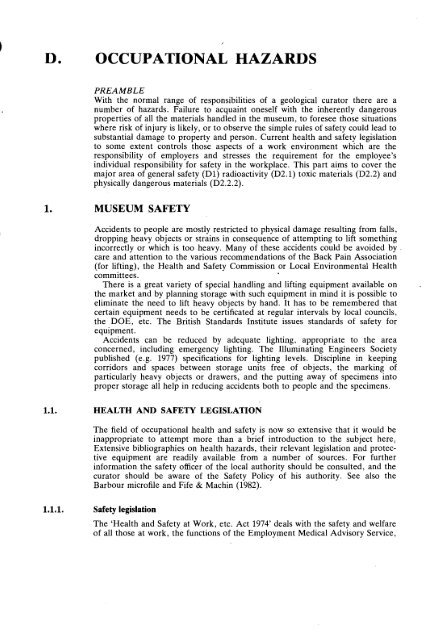GUIDELINES FOR THE CURATION OF GEOLOGICAL MATERIALS
GUIDELINES FOR THE CURATION OF GEOLOGICAL MATERIALS
GUIDELINES FOR THE CURATION OF GEOLOGICAL MATERIALS
You also want an ePaper? Increase the reach of your titles
YUMPU automatically turns print PDFs into web optimized ePapers that Google loves.
OCCUPATIONAL HAZARDS <br />
PREAMBLE<br />
With the normal range of responsibilities of a geological curator there are a<br />
number of hazards. Failure to acquaint oneself with the inherently dangerous<br />
properties of all the materials handled in the museum, to foresee those situations<br />
where risk of injury is likely, or to observe the simple rules of safety could lead to<br />
substantial damage to property and person. Current health and safety legislation<br />
to some extent controls those aspects of a work environment which are the<br />
responsibility of employers and stresses the requirement for the employee's<br />
individual responsibility for safety in the workplace. This part aims to cover the<br />
major area of general safety (Dl) radioactivity (D2.1) toxic materials (D2.2) and<br />
physically dangerous materials (D2.2.2).<br />
MUSEUM SAFETY<br />
Accidents to people are mostly restricted to physical damage resulting from falls,<br />
dropping heavy objects or strains in consequence of attempting to lift something<br />
incorrectly or which is too heavy. Many of these accidents could be avoided by<br />
care and attention to the various recommendations of the Back Pain Association<br />
(for lifting), the Health and Safety Commission or Local Environmental Health<br />
committees.<br />
There is a great variety of special handling and lifting equipment available on<br />
the market and by planning storage with such equipment in mind it is possible to<br />
eliminate the need to lift heavy objects by hand. It has to be remembered that<br />
certain equipment needs to be certificated at regular intervals by local councils,<br />
the DOE, etc. The British Standards Institute issues standards of safety for<br />
equipment.<br />
Accidents can be reduced by adequate lighting, appropriate to the area<br />
concerned, including emergency lighting. The Illuminating Engineers Society<br />
published (e.g. 1977) specifications for lighting levels. Discipline in keeping<br />
corridors and spaces between storage units free of objects, the marking of<br />
particularly heavy objects or drawers, and the putting away of specimens into<br />
proper storage all help in reducing accidents both to people and the specimens.<br />
HEALTH AND SAFETY LEGISLATION<br />
The field of occupational health and safety is now so extensive that it would be<br />
inappropriate to attempt more than a brief introduction to the subject here,<br />
Extensive bibliographies on health hazards, their relevant legislation and protective<br />
equipment are readily available from a number of sources. For further<br />
information the safety officer of the local authority should be consulted, and the<br />
curator should be aware of the Safety Policy of his authority. See also the<br />
Barbour microfile and Fife & Machin (1982).<br />
1.1.1. Safety legislation<br />
The 'Health and Safety at Work, etc. Act 1974' deals with the safety and welfare<br />
of all those at work, the functions of the Employment Medical Advisory Service,

















